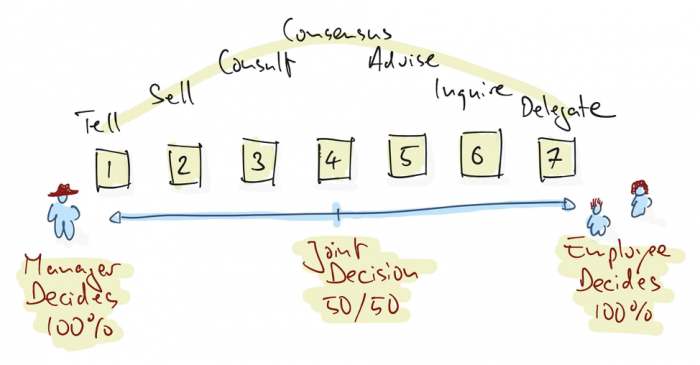THE BENEFITS
Your horror scenario: when you’re not on site your employees sit around lazily and nobody does anything. And if they actually work, you don’t have the usual control over the quality of the work results. Or the chance to give detailed instructions to every single person… Wait. Do you notice something? That’s right, the „command & control“ style of leadership doesn’t get us anywhere in the long run. To that end, let’s think a little more carefully about the topic of „delegation“.
HOW IT’S DONE
As you may already know, each employee and each task requires to be treated in a different way in different situations – this also goes for delegating tasks. There a different levels of delegation:

Consider all tasks as an opportunity of development for your employees and ask yourself: “Who should decide what and to which degree?” You have seven options:
Tell: You decide and inform the employee about the concrete task.
Sell: You decide, inform the employee about the task, explain your motivation and answer questions.
Consult: You ask the employee for input first, take this into consideration and then decide on how the task is to be completed.
Agree: You enter into a discussion with everyone involved and find a consensus on how the task will be completed.
Advise: Your collaborator decides how the task will be done after you have offered your input.
Inquire: Your collaborator decides, informs you and answers your questions.
Delegate: Your employee decides independently without your participation.
Present these levels to your employees and decide together which tasks you will delegate to them on which delegation level. If you and your employees can’t consent to the delegation level (e.g. you prefer “consult”, your employee prefers “delegate”), you can meet in the middle. This way responsibilities are always transparent to everyone involved. This tool is called „Delegation Poker“ and has its origin in the toolbox „Management 3.0“ (www.management30.com).
PLEASE CONSIDER
You can use the tool on an individual and team level. In general, it is recommendable to explain the tool in a 1:1 conversation and to use it on an individual level first. This will facilitate a common understanding at team level. Use a whiteboard or other visualization tools to jot down your agreements.
Delegate dynamically! Don’t get stuck on a certain level of delegation that you and your employee once agreed on, but rather develop step by step to a higher level of delegation.
But be careful: use this form of delegation only if you really want to have a dialogue. Don’t create a feeling of participation if you want to decide on your own anyway.

